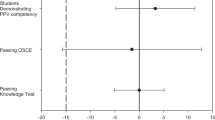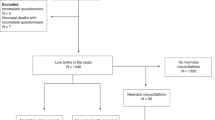Abstract
OBJECTIVE: To determine if health care personnel trained in the Neonatal Resuscitation Program (NRP) used the NRP guidelines in the resuscitation of newborn babies. To determine differences between self-reporting and documentation of resuscitation in medical records.
STUDY DESIGN: Using a validated questionnaire, individuals participating in resuscitation of newborns voluntarily phoned and answered questions on an Interactive Voice Response (IVR) system. The study was undertaken in level II hospitals in Southern Alberta with 7500 deliveries per year.
RESULTS: Of the 5155 babies delivered during the study, 16% required resuscitation (bag and mask ventilation 10.6%, intubation for meconium or intermittent positive pressure ventilation, IPPV, 3.6%, cardiac massage, CM, 0.3%, epinephrine 0.1%, naloxone 6.9%). Of babies whose interventions could be assessed, bag and mask was correct in 99%, endotracheal intubation for IPPV in 100%, and CM in 100%. Only 75% of babies had meconium managed correctly and 92% had naloxone administered according to guidelines. There were more instances where IVR (48) reported a procedure, which was not charted versus charted and not reported by IVR (21). Educational needs identified by IVR included skills of resuscitation and NRP indications for management.
CONCLUSION: Bag and mask ventilation and intubation for neonatal resuscitation are more common than previously reported. Management of the meconium-stained baby and use of naloxone require further education. Compared to charts, use of IVR system allows more complete documentation with rationale of interventions and identification of continuing educational needs.
This is a preview of subscription content, access via your institution
Access options
Subscribe to this journal
Receive 12 print issues and online access
$259.00 per year
only $21.58 per issue
Buy this article
- Purchase on Springer Link
- Instant access to full article PDF
Prices may be subject to local taxes which are calculated during checkout
Similar content being viewed by others
References
Paneth N Etiologic factors in cerebral palsy Pediatr Ann 1998 15 191–201
McDonald HM, Mulligan JC, Allen AC, et al Neonatal asphyxia: I. Relationship of obstetrical and neonatal complication to neonatal morbidity in 38,405 consecutive deliveries J Pediatr 1980 96 898–902
Perlman JM, Risser R Cardiopulmonary resuscitation in the delivery room Arch Paediatr Adolesc Med 1995 149 20–5
Wiswell TE, Tuggle JM, Turner BS Meconium aspiration syndrome: have we made a difference? Pediatrics 1990 85 715–21
Wiswell TE, Fulopia M Management of meconium-stained amniotic fluid Clin Perinatol 1999 26 659–68
Chance GW, Hanvey L Neonatal resuscitation in Canadian hospitals Can Med Assoc J 1987 136 601–6
Bloom RS, Cropley C In: American Heart Association, American Academy of Pediatrics, eds. Textbook of Neonatal Resuscitation. Professional Education Program, American Heart Association, and American Academy of Pediatrics Chicago, Illinois, USA: American Academy of Pediatrics 1996
Singhal N, McMillan DD, Lockyer JM, et al Attitudinal and resource changes after a neonatal resuscitation training program Neonat Network 1992 11 37–40
Kosecoff J, Kanouse DE, Rogers WH, et al Effects of the National Institutes of Health Consensus Development Program on Physician Practice J Am Med Assoc 1987 258 2708–13
Hill MN, Levine DM, Whelton PK Awareness, use and impact of the 1984 Joint National Committee Consensus Report on High Blood Pressure Am J Public Health 1988 78 1190–4
Battista RN Adult cancer prevention in primary care: patterns of practice in Quebec Am J Public Health 1983 73 1036–9
Fox RD, Mazmanian PE, Putnam RW Changing and learning in the lives of physicians New York: Praeger 1989 pp. 161–75
Lockyer JM, Parboosingh JT, McDougall GM, et al How physicians integrate advances into clinical practice Mobius 1985 5 5–12
Parboosingh J, Avard D, Lockyer J, et al The use of clinical recall interviews as a method of determining needs: I. Continuing medical education Proc Assoc Am Med Coll Res Med Educ Conf 1987 11 103–8
Lockyer JM, McMillan DD, Magnan L, et al Stimulated case recall interviews applied to a national protocol for hyperbilirubinemia J Contin Educ Health Prof 1991 11 129–37
Fung K, Fung MP, Parboosingh IJT, Temple LM, d'Anjou CG, Haege J, Lussier R Development of a computerized telecommunication system for in-training evaluation of residents in a laparoscopic education program Obstet Gynecol 1997 90 148–52
Kaczorowski J, Levitt C, Hammond M, Outerbridge E, Grad R, Rothman A, Graves L Retention of neonatal resuscitation skills and knowledge: a randomized controlled trial Fam Med 1998 30 705–11
Goetting MG Mastering pediatric cardiopulmonary resuscitation Pediatr Clin North Am 1994 41 1147–82
Ryan CA, Clark LM, Malone A, et al The effect of a structured neonatal resuscitation program on delivery room practices Neonat Network 1999 18 25–30
Niermeyer S, Kattwinkle J, Van Reempts P, et al International Guidelines for Neonatal Resuscitation: an excerpt from the Guidelines 2000 for Cardiopulmonary Resuscitation and Emergency Cardiovascular Care: International Consensus on Science Pediatrics 2000 e29 103
Committee on Fetus and Newborn, Committee on Drugs, Section on Anesthesiology, and Section on Surgery Prevention and management of pain and stress in the neonate Pediatrics 2000 105 454–61
Cabana MD, Rand CS, Powe NR, Wu AW, Abboud PAC, Rubin HR Why don't physicians follow clinical practice guidelines? A framework for improvement J Am Med Assoc 1999 282 1458–65
Acknowledgements
We acknowledge the contributions of K. Aziz in encouraging the team to report resuscitations and Andrew Mah with the data analysis in this study.
Author information
Authors and Affiliations
Rights and permissions
About this article
Cite this article
Singhal, N., McMillan, D., Yee, W. et al. Evaluation of the Effectiveness of the Standardized Neonatal Resuscitation Program. J Perinatol 21, 388–392 (2001). https://doi.org/10.1038/sj.jp.7210551
Published:
Issue Date:
DOI: https://doi.org/10.1038/sj.jp.7210551
This article is cited by
-
Standards zur Versorgung von reifen Neugeborenen in Österreich
Monatsschrift Kinderheilkunde (2011)
-
Erstversorgung von Neugeborenen
Monatsschrift Kinderheilkunde (2010)
-
Neonatale reanimatievaardigheden van arts-assistenten kindergeneeskunde
Tijdschrift voor Kindergeneeskunde (2008)



